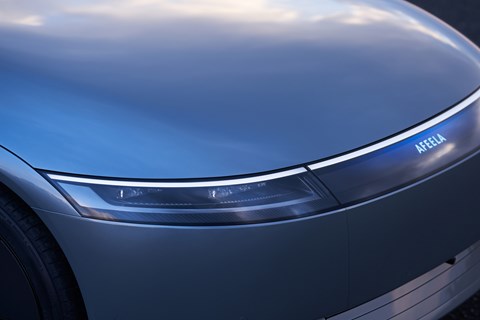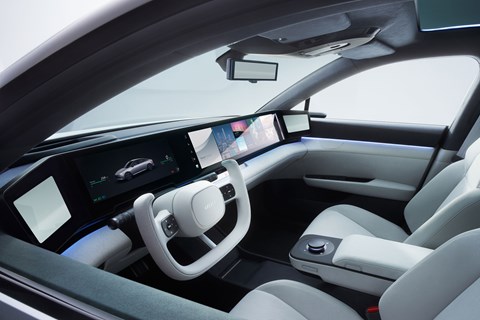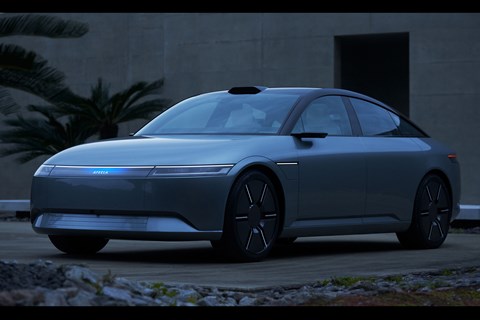► Sony and Honda’s joint venture kicks off
► New Afeela brand brings two together
► This is the first prototype from the tie-up
Sony has been toying for years about getting into the automotive sphere, even announcing it would join forces with Honda to do just that. This is the first product of the joint venture, which kicks off a new brand: Afeela.
The Afeela brand was announced at the 2023 Consumer Electronics Show in Las Vegas, embodied in this prototype electric car that taken heavy inspiration from Sony’s Vision S and Vision S 02 concepts. But this time, Sony Honda Mobility director, chairman and CEO – Yasuhide Mizuno – announced it would make production in 2025.
Best electric cars
It’s unfortunately been created in a jungle of marketing speak. SHM says Afeela ‘expresses an interactive relationship where people FEEL mobility as an intelligent entity, and where mobility FEELs people and society.’
Afeela? Why that?

Well done for making through that paragraph without barfing.
What about the car?
It’s currently a nameless prototype but, as mentioned, takes heavy inspiration from Sony’s previous concept cars. The design is minimalist – almost as if Hyundai put its new Ioniq 6 through an industrial sander – with a ‘media bar’ on the front that’s in full colour and allows the vehicle to communicate.
‘You can see a lot of the inspiration came from Vision S,’ Afeela’s product marketing manager Larry Harrison tells CAR. ‘So we weren’t starting from scratch at Ground Zero. We were starting from a point where we were very happy, and it was how do we build on that collaboratively?’
Inside, it’s clean and smashes together inspirations from BMW, Hyundai and even Tesla. What we mean by that is big sweeping screens, angled screens for camera mirrors, a ‘floating’ centre console and a yoke-like steering wheel.
‘Vision S had three individual screens,’ Harrison tells CAR. ‘You had the driver or primary cockpit screen, and then you had two separate tablets both centre and then on passenger side.
On the Afeela, you still have the segmented or separated driver display with a yoke steering wheel,’ Harrison explains. ‘But everything else is a panoramic display all seamlessly put together, so controls can be swiped and moved from the centre of the car all the way to the passenger.’

Given Sony’s experience in the media world, it’s working with Qualcomm and Epic Games to make sure the real production car has the latest and greatest computing power, access to all different kinds of media while you’re on board as well as the use of augmented reality.
There’s also Bravia Core; streaming technology carried over from the brand’s flatscreen TVs.
SMH promises Level 3 automated driving and Level 2+ driver assistance tech via an array of cameras, sensors and lidar. There are 45 cameras and sensors both inside and outside.
‘When we think about autonomous vehicles, a lot of times we think about just the driving aspect of it,’ Harrison continues. ‘But you’ll notice the car doesn’t have door handles. So that autonomous experience should start even before you enter the vehicle.’
‘So you see on the side pillars there’s a camera sensor there as well as several sensors that are on the side-view cameras. You can preset it facial recognition, identify your proximity and doors automatically open for you.’
The outside of the car also displays information such as cabin information, sports scores and other user oriented information on two screens on either end of the car.
Next to no performance specs of the prototype are made public, apart from its dimensions (where it’s just a smidge longer and wider than an Ioniq 6) with double wishbone front/multilink rear suspension. The prototype is all-wheel drive, too, implying the use of at least two e-motors underneath the skin.

How close is this to the finished car?
‘I can’t put a percentage on it, but it’s extremely close,’ Harrison tells us. ‘The prototype is already going through some on road vehicle testing and things of that nature. So when you get to that level of – that’s just this is why I talk concept and then prototype – prototype is very close to final production. So it’s extremely worse, I can’t quantify it.’